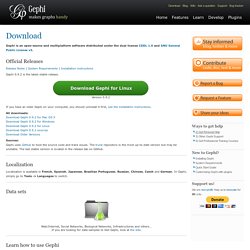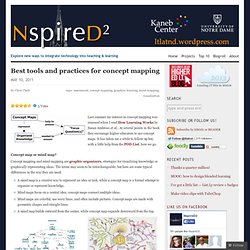

Downloads. Gephi is an open-source and multiplatform software distributed under the dual license CDDL 1.0 and GNU General Public License v3.

Official Releases Release Notes | System Requirements | Installation instructions Gephi 0.9.2 is the latest stable release. Download Gephi for LinuxVersion 0.9.2 If you have an older Gephi on your computer, you should uninstall it first, see the installation instructions. All downloads:Download Gephi 0.9.2 for Mac OS XDownload Gephi 0.9.2 for WindowsDownload Gephi 0.9.2 for LinuxDownload Gephi 0.9.2 sourcesDownload Older Versions Sources: Gephi uses GitHub to host the source code and track issues. Localization Localization is available in French, Spanish, Japanese, Brazilian Portuguese, Russian, Chinese, Czech and German.
Data sets Web/Internet, Social Networks, Biological Networks, Infrastructures and others… If you are looking for data samples to test Gephi, look at the wiki. Learn how to use Gephi Thank you for your support! Diagramming Components for HTML5/Canvas, by Northwoods Software® Best tools and practices for concept mapping. Last summer my interest in concept mapping was renewed when I read How Learning Works by Susan Ambrose et al..

At several points in the book they encourage higher educators to use concept maps. It has taken me a while to follow up but, with a little help from the POD List, here we go. Concept map or mind map? Concept mapping and mind mapping are graphic organizers, strategies for visualizing knowledge or graphically representing ideas. The terms may seem to be interchangeable, but here are some typical differences in the way they are used: A mind map is a creative way to represent an idea or task, while a concept map is a formal attempt to organize or represent knowledge.Mind maps focus on a central idea; concept maps connect multiple ideas.Mind maps are colorful, use wavy lines, and often include pictures.
“Mind Map” is a registered trademark, so it may be less problematic to use “concept map” for everything. Uses of concept maps Practices to consider Software Resources Articles. About Us. What is VUE?

At its core, the Visual Understanding Environment (VUE) is a concept and content mapping application, developed to support teaching, learning and research and for anyone who needs to organize, contextualize, and access digital information. Using a simple set of tools and a basic visual grammar consisting of nodes and links, faculty and students can map relationships between concepts, ideas and digital content. Concept mapping is not new to the educational field. Brainstorm and mind map online. About perspective... by Adam Somlai-Fischer on Prezi. CmapTools - Documentation. The CmapTools documentation is organized as a Knowledge Model composed of concept maps and associated resources, constructed with CmapTools itself.

The following is a categorized list of the Cmaps in the Knowledge Model, for direct access. Home Cmap for the Site Home Cmap of the CmapTools Web site General Descriptions of the CmapTools Toolkit Root Cmap: General Description of Software General Description of the Network Architecture of CmapTools Description of the Various Collaboration Features of CmapTools The Views: Storing and Organizing Cmaps and Knowledge Models on the Network, plus History and Favorites My Cmaps: Storing and Organizing Cmaps and Knowledge Models in your Computer Automatic and On-Demand Generation of Web Page versions of Cmaps User IDs and Passwords for Identification during Collaboration and for Permissions Specific Collaboration Features of CmapTools Synchronous Collaboration: Two or more Users Editing the Same Cmap at the Same Time (Concurrently), with Chat.